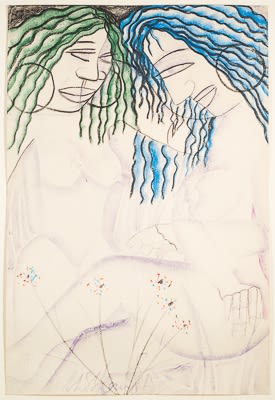A self-taught artist, musician and poet Sekano has consistently drawn on the love of his mother and sisters and from his formative years in South Africa to inform his practice. The effects of his history, the tragic experience of apartheid and of the difficulties of exile (30 years in Kenya), are evident in the pictorial space that Sekano creates. In opposition to the dramatic reality of his life, his pastels transport us into colourful tableaux of intimate scenes of carefree reverie, fantasy, innocence and freedom – an almost heavenly vision tinged with earthly emotions. Memory, imagination and reality seemingly merge to give rise to these highly distinctive works.
Sekano takes us on a journey of exploration, filled with an acute interest and sensitivity to emotions, moods and character. Noticeably, the men and women’s faces are filled with very specific emotions. Their eyes are either closed or cast down, often gazing away pointing to a moment of self-reflection. The many characters in his work serves as a tribute and testament to the diversity of people in Kenya where the artist was exiled and are at once daring and melancholic, strong and vulnerable. The passion, fervor, sadness and pride on display call us to empathize with and to immerse ourselves in Sekano’s world. Sekano is inspired by traditional African forms and use of colours. The influence of Picasso, Matisse and cubism is also felt in Sekano’s practice (in the same way that African masks had inspired Picasso in the past). Bodly applied expressive pastel strokes belie meticulously conceived compositions. The works clearly engage with balance of forms, our gaze is forced to consider the entirety of the work, every inch is significant to the whole. The pastel is at time applied in thick opaque markings and at other times as thinner translucent washes. Colour is applied with force, a flash of burnt orange or a scrape of ochre butts up against an energetic mix of vibrating vivid greens, whilst a lick of sumptuous brown or red emerges. Deep blues, greens, violet, champagne, lemon and vivid fushia are deployed in a harmonious and delicate balance, soft hues merge with deeper denser tones. Colours plays a vital role in fusing people and nature, in grounding the characters in their environment, in the here and now. Shapes and colours fuse to turn the artist’s ideas in remarkable vision.
Whilst a love of geometric shapes had informed all his work from the outset it was not until 2007 that Sekano started to develop a new way of working and seeing based predominantly on the use of coloured squares and rectangles in his work. For Sekano the four sides of the square and rectangle have come to symbolize the walls of human structures such as houses and even graves – structures that often define us and inform our aspirations. Thus the squares and rectangles that combine to form his figures such as in Memory of the Forest and Girl with a Sun Hat represents human structures – houses that contemporary South Africa has failed to facilitate for its people.
For Sekano the geometric shapes symbolize the building process of life itself and in these beautiful and powerful works we see the coming together of memory, of self-fulfillment and expression, and life’s geometry of dreams, hopes and realities. Other works exploring musicians’ collaboration, such as Jazz Women (1992) shows naked women swirling around saxophones and pianos. Bodies and musical instrument fusing in a harmony of shapes, with a classically jazz inspired nostalgia. Music and rhythm are celebrated by Sekano, both in the theme represented and in the choice of lines, visual cues and cadenced composition of the works. Similarly in Jazz Dancers (1987), men and women move to the rhythm of a saxophone, the central character, a women wearing a red hat and sporting red hair, purple skin and violet dress, dance with a partner, an aquamarine blue figure. The dancers are intertwined in flow of rhythm and colors and somewhat fuse with the lush green garden in the background. The characters populating Sekano’s drawing are not bound by race or time. Caught in timeless and joyful moments, in all the colours of the rainbow, blue, red, purple or yellow, and in this way defy all racial categorization. Popi & Nana (1988) a pastel on paper of his sisters, unveil two brightly colored women, their skin bright yellow and vivid fushia.
Sekano consciously waged his own war on apartheid’s politics of colour with colour itself as his weapon. Cohabitating with Jazz, nature figures strongly in Seknao’s drawings inspired by visions of pristine African landscapes. Women are portrayed walking, working or playing in fields of lush green grass at times filled with small burgeoning flowers against which their silhouettes are offset such as in Sleeping Bathers (2008). In Bathers (1992-1994) yellow sky, red mountains, foliage and trees form at once the foreground and background to the portrayal of sensuous women half submerged in a river.
Sekano’s compositions, colours and portraiture, whilst drawn vividly from Africa, convey universal values. Unique portraits of strong, peaceful and talented characters embody the artist vision and desire to create an artistic world filled with the universal values of peace and knowledge.
